
In aviation, instrument flight rules (IFR) is one of two sets of regulations governing all aspects of civil aviation aircraft operations; the other is visual flight rules (VFR).
In aviation, visual flight rules (VFR) are a set of regulations under which a pilot operates an aircraft in weather conditions generally clear enough to allow the pilot to see where the aircraft is going. Specifically, the weather must be better than basic VFR weather minima, i.e. in visual meteorological conditions (VMC), as specified in the rules of the relevant aviation authority. The pilot must be able to operate the aircraft with visual reference to the ground, and by visually avoiding obstructions and other aircraft.

An airport is an aerodrome with extended facilities, mostly for commercial air transport. Airports usually consists of a landing area, which comprises an aerially accessible open space including at least one operationally active surface such as a runway for a plane to take off and to land or a helipad, and often includes adjacent utility buildings such as control towers, hangars and terminals, to maintain and monitor aircraft. Larger airports may have airport aprons, taxiway bridges, air traffic control centres, passenger facilities such as restaurants and lounges, and emergency services. In some countries, the US in particular, airports also typically have one or more fixed-base operators, serving general aviation.
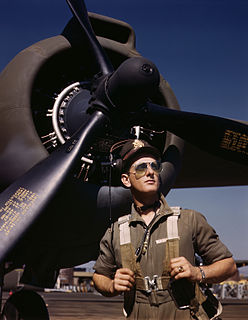
An aircraft pilot or aviator is a person who controls the flight of an aircraft by operating its directional flight controls. Some other aircrew members, such as navigators or flight engineers, are also considered aviators, because they are involved in operating the aircraft's navigation and engine systems. Other aircrew members, such as drone operators, flight attendants, mechanics and ground crew, are not classified as aviators.
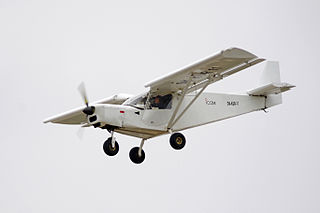
A short takeoff and landing (STOL) aircraft is a conventional fixed-wing aircraft that has short runway requirements for takeoff and landing. Many STOL-designed aircraft also feature various arrangements for use on airstrips with harsh conditions. STOL aircraft, including those used in scheduled passenger airline operations, have also been operated from STOLport airfields which feature short runways.

A business jet, private jet, or bizjet is a jet aircraft designed for transporting small groups of people. Business jets may be adapted for other roles, such as the evacuation of casualties or express parcel deliveries, and some are used by public bodies, government officials or the armed forces.

Air North Charter and Training Ltd., operating as Air North, Yukon's Airline, is a Canadian airline based in Whitehorse, Yukon. It operates scheduled passenger and cargo flights throughout Yukon, as well as between Yukon and the Northwest Territories, British Columbia, Alberta, and Ontario. The airline also operates charter flights throughout Canada and Alaska. The airline also provides ground handling services and fuel services to other airlines throughout Yukon, and it also provides ground handling services at Vancouver International Airport and Edmonton International Airport. Its main base is Erik Nielsen Whitehorse International Airport.
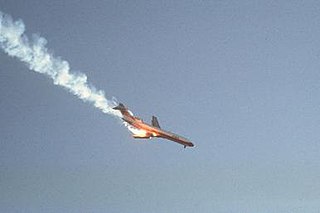
Pacific Southwest Airlines (PSA) Flight 182 was a scheduled flight of Pacific Southwest Airlines from Sacramento to Los Angeles and San Diego. On September 25, 1978, the Boeing 727-214 serving the flight, registration N533PS, collided with a private Cessna 172 light aircraft, registration N7711G, over San Diego, California. It was Pacific Southwest Airlines' first fatal accident, and the deadliest air disaster in California history.

The Cessna 208 Caravan is a utility aircraft produced by Cessna. The project was commenced on November 20, 1981, and the prototype first flew on December 9, 1982. The production model was certified by the FAA in October 1984 and its Cargomaster freighter variant was developed for FedEx. The 4 ft (1.2 m) longer 208B Super Cargomaster first flew in 1986 and was developed into the passenger 208B Grand Caravan.
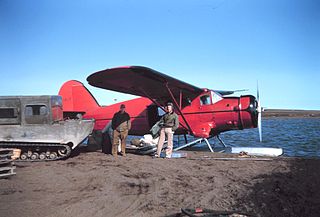
Bush flying refers to aircraft operations carried out in the bush. Bush flying involves operations in rough terrain where there are often no prepared landing strips or runways, frequently necessitating that bush planes be equipped with abnormally large tires, floats, skis or any other equipment necessary for unpaved runway operation. It is the only viable way of delivering people and supplies into more difficult to reach, remote locations.
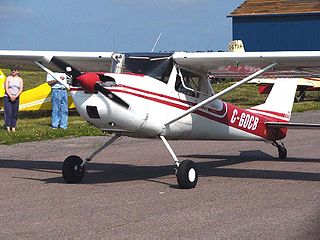
Conventional landing gear, or tailwheel-type landing gear, is an aircraft undercarriage consisting of two main wheels forward of the center of gravity and a small wheel or skid to support the tail. The term taildragger is also used, although some argue it should apply only to those aircraft with a tailskid rather than a wheel.

A radio-controlled aircraft is a small flying machine that is controlled remotely by an operator on the ground using a hand-held radio transmitter. The transmitter continuously communicates with a receiver within the craft that sends signals to servomechanisms (servos) which move the control surfaces based on the position of joysticks on the transmitter. The control surfaces, in turn, directly affect the orientation of the plane.
Montréal/Mascouche Airport, formerly TC LID: CSK3, was a small, general aviation airport located 1.5 nautical miles southeast of Mascouche and approximately 20 km (12 mi) northeast of Montreal, Quebec, Canada. It was reached by Autoroute 640 at exit 44. The runway was parallel to Autoroute 640. Montréal/Mascouche Airport closed 15 November 2016 and all aircraft had to be removed by 13 November.

A yoke, alternatively known as a control wheel or a control column, is a device used for piloting some fixed-wing aircraft.

San Luis Obispo County Regional Airport, McChesney Field is a civil airport near San Luis Obispo, California, United States. Three passenger airlines serve the airport with nonstop flights to eight cities: Dallas-Fort Worth, Denver, Los Angeles, Phoenix, Portland, San Diego, San Francisco and Seattle. The airport was established in 1939 and used by the U.S. military between 1939 and 1945.
Taunton Municipal Airport, also known as King Field, is a public use airport located three nautical miles (6 km) east of the central business district of Taunton, a city in Bristol County, Massachusetts. It is located in the East Taunton neighborhood of the city. The city-owned airport is maintained and operated by the Taunton Airport Commission. According to the FAA's National Plan of Integrated Airport Systems for 2009–2013, it is categorized as a general aviation airport.

Plum Island Airport, in Newburyport, Massachusetts, is a privately owned, public-use airport owned by Historic New England and operated by Plum Island Aerodrome, Inc., a non-profit corporation. It has two runways, averages 54 flights per week, and has approximately 8 based aircraft.

The Yellow Jacket Flying Club (YJFC) is a non-profit, student run organization at Georgia Tech in Atlanta, Georgia which exists to provide opportunities for those in the Georgia Tech community to pursue their passion for aviation. The YJFC is open to Georgia Tech students, faculty and staff, alumni, and their immediate families and is one of the few well-established university affiliated flying clubs in the United States.

The Cessna 500 Citation I is a small business jet produced by Cessna, the basis of the Citation family. Announced in October 1968, the Fanjet 500 prototype first flew on September 15, 1969 and it was certified as the 500 Citation on September 9, 1971. It was upgraded in 1976 as the Citation I, and the 501 Citation I/SP single-pilot variant was introduced in 1977. Production ended in 1985 with 689 of all variants produced. The straight wing jet is powered by JT15D turbofans. The aircraft was developed into the Citation II.
Dwane Leon Wallace was an American aviation businessman and aircraft designer. He served as the president and/or chairman of the board of the Cessna Aircraft Company from 1935 until the 1970s, having then continued on the board as a director and consultant into the 1980s. Wallace later became known as the "Quiet Giant of Aviation", and was posthumously inducted into the National Aviation Hall of Fame in 2012. He was included in the Flying Magazine list of the "51 Heroes of Aviation", placing at number 11.
















